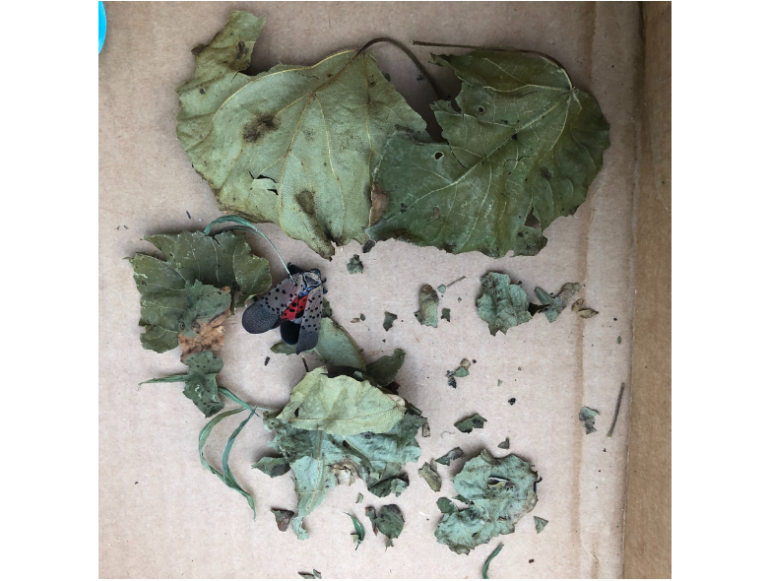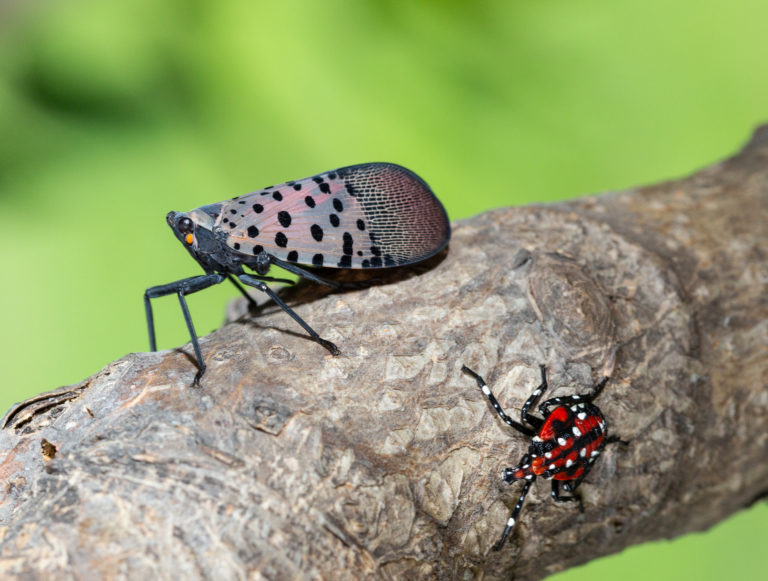Natural Spotted Lanternfly Control

Stop The Bites®!: A Natural Spotted Lanternfly Treatment
Integrated Pest management (IPM) is the key to controlling the current Spotted Lanternfly (SLF) infestation. When done properly IPM will disrupt the Spotted Lanternfly (Lycorma delicatula) life cycle and prevent the spread of SLF outside the current Spotted Lanternfly infestation zones. Stop The Bites®! can be an effective tool, when used as part of an IPM plan, for Natural and effective Spotted Lanternfly control.
We are pleased to announce a new tool to help in the IPM approach to control Spotted Lanternfly. Stop The Bites®! is a Natural product that is an excellent Spotted Lanternfly treatment on both Spotted Lanternfly nymphs and Spotted Lanternfly adults. Recent tests conducted by Arkion® Life Sciences show that Stop The Bites®! is effective at controlling Spotted Lanternfly as a contact spray and as a residual control tool for up to 19 days.
With the IPM approach spraying for Spotted Lanternfly nymphs can be done May through September while spraying for Spotted Lanternfly adults can be done from July through the end of December. More information about the Spotted Lanternfly life cycle and IPM can be found here. We recommend you consult your state’s extension service website for state specific recommendations for controlling Spotted Lanternfly in your local area.
Results of Stop The Bites®! Direct Application Tests On Spotted Lanternfly Nymphs and Adults
In August 2020 the Arkion® Life Sciences product development team conducted experiments aimed at answering three main questions:
- Does Stop The Bites®! kill Spotted Lanternfly adults when sprayed directly? – Yes it does.
- Does Stop The Bites®! kill Spotted Lanternfly nymphs when sprayed directly? – Yes it does.
- Does Stop The Bites®! provide residual kill for Spotted Lanternfly when applied to vegetation? Yes it does, for up to 19 days.
Test 1 – Answering questions 1 & 2 above: Does Stop The Bites®! kill Spotted Lanternfly adults
and nymphs?
Direct Application Control Test Location & Materials:
Tests were conducted in Delaware using wild Spotted Lanternfly nymphs and adults. Nymphs used in the tests ranged in size from second instars to mature fourth instars.
Two direct spray tests were conducted. One on the trunk of a Black Walnut tree (Juglans nigra) and the other on the trunk of a Tree of Heaven (Ailanthus altissima). Dozens of adults and nymphs were present on the trunks of both trees at the time of application. Spray was applied at a distance of 2 feet from the trunk of the tree. Sprayer used was a small hand pump sprayer. Spray was applied until surface of the tree and insects were coated in spray.
All adults and nymphs present died within 10 mins after application. Smaller nymphs died more quickly, most were dead within the first 60 seconds. The largest of the adults took up to ten minutes to die.

Conclusion:
Stop The Bites®! is an effective Natural product to control Spotted Lanternfly with direct contact applications.
Test 2 – Does Stop The Bites®! provide residual kill for Spotted Lanternfly when applied to vegetation?
Residual Application Test Location & Materials:
Tests were conducted in Delaware using wild caught Spotted Lanternfly nymphs and adults. Nymphs used in the tests ranged in size from second instars to mature fourth instars. They were all collected from untreated Tree of Heaven (Ailanthus altissima) trees.
50 grams of grape leaves were treated with Stop The Bites®! and allowed to weather outside for 24 hours. The leaves were then placed in large cans with netting at the top (pictured below). These same treated leaves remained in the treatment cans throughout the test.
Each day for 20 days new Spotted Lanternfly nymphs and adults were introduced to two cans containing the treated grape leaves. Each day new Spotted Lanternfly nymphs and adults were added to the control can containing untreated grape leaves.
Large cans with netting were used as a containment area for the Spotted Lanternflies nymphs and adults during exposure testing.
.


New “control” nymphs and adults were also placed in with untreated leaves in a control can each day. These test subjects continued to move around and act lively. No mortality was observed in the control cans at any point during the 20 days of the trial. Each day after observations were completed, these control Spotted Lanternfly were dispatched using the bottom-of-the-boot method. (They are invasive pests after all.)
In the two treatments containing treated leaves, the dried grape leaves killed lanternfly nymphs and adults for 19 days, at 100% mortality within one to two hours. On day 20 nymphs died at 100% within 1 hour and adults began to take upwards of 3 hours to die. At this time, the test was stopped. Our team believed that exposure to treated vegetation in an experimental chamber for upwards of 3 hours does not indicate what happens in the real world. Our goal was for these tests to reflect real world applications as much as possible.
Conclusion:
Stop The Bites®! provides up to 19 days of residual control for Spotted Lanternfly nymphs and adults.

Stop The Bites® ! Summary Statement & Recommendation:
This research supports reports from practitioners currently using Stop The Bites®! in the field to control Spotted Lanternfly. We feel confident in recommending Stop The Bites! as a Natural tool to use as part of an IPM strategy. The Arkion® Life Sciences development team has concluded from our tests that Stop the Bites® kills the Spotted Lanternfly when sprayed directly, and also has good residual kill on both nymphs and adult Spotted Lanternfly for up to 19 days.
Because of the size and mass of the adult Spotted Lanternfly, we recommend a mix rate of 8 – 10 ounces of Stop The Bites®! per gallon of water. Please note this is a higher rate than we recommend for treatments targeting mosquitoes and ticks. Also note – Stop The Bites! is NOT for use on agricultural crops. Do not spray on food-bearing plants or trees. Please read and follow all other label directions.
Our team will continue to research this topic and collect more specific data for our recommendations. We understand that these trials were not conducted to rigorous academic standards. Our trials were field-based in an effort to provide real information that practitioners can use in the field. We understand that the Spotted Lanternfly situation is urgent and we are doing our best to support all of the excellent work being done across the impacted areas. We are committed to providing the impacted communities with the very best tools possible.